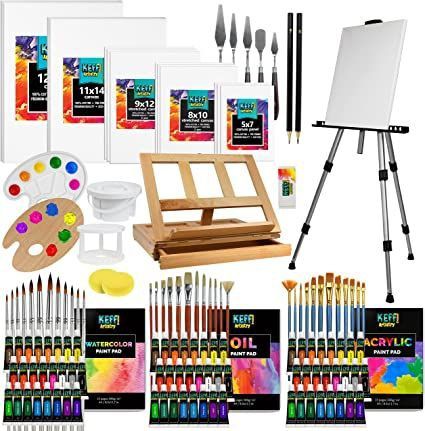We've all been there—standing in front of the art supply store shelves, dreaming of filling our carts with juicy tubes of high-end oil paint or that perfect heavy-duty drawing tablet. But then reality hits: your budget sadly doesn't stretch that far.
Whether you're a hobbyist or a professional artist, finances play a huge role in how you create and buy art. The good news? You don't need to compromise quality to save money. Let's dive into some practical, tested strategies to help you balance creativity and budget.
Understanding Budget Constraints in the Art Industry
Before we dive into solutions, let's quickly touch on why budgeting in the art world is uniquely challenging. Many artists, especially freelancers, face unpredictable income streams. And when you're shopping for art supplies, it's easy to overspend because quality materials often come with higher prices.
Art buyers and collectors aren't immune either. Limited budget doesn't mean you have to settle for sub-standard pieces or amateur looking presentation. The key isn't in spending more, but in spending smarter.
As Zara, a freelance illustrator of five years, shares, "The hardest part was figuring out where I could cut corners without hurting my work. Once I found my rhythm, budgeting became second nature."
Tips for Cutting Costs Without Sacrificing Quality

1. Buy in Bulk Where Possible
Buying supplies you frequently use—like brushes, sketchpads, or acrylic paints—in bulk can drastically bring down your costs per unit.
Who it's good for: Artists with consistent workflows and regular demand for certain supplies.
Why it's great: You'll save money per item and reduce frequent trips, saving time and fuel.
How to do it: Identify what you use frequently and find wholesalers or online marketplaces like Jerry's Artarama or Blick Art Materials. Consider teaming up with other artists to split the costs and reduce waste.
2. Invest in Reusable or Multi-purpose Tools
Sometimes the secret to budget-friendly creativity lies in versatility.
Example story: My friend Kat, a hobby artist, felt pressured to buy specific brushes for each individual medium—watercolors, acrylics, inks. She soon realized quality synthetic brushes worked just as well across all the mediums she loved.
Why it's helpful: Invest in versatile, reusable, washable, and durable tools. Fewer tools mean less clutter and more money in your pocket.
3. DIY Solutions and Upcycling
You don't always need expensive custom solutions—sometimes creativity involves improvisation.
Real-life use: Need a versatile mixing palette or storage? Many artists use egg cartons, mason jars, or thrifted frames instead of pricey alternatives.
Who benefits: Anyone wanting to explore eco-friendly and cost-cutting measures.
How to start: Look around home or thrift stores for everyday items that can be reshaped for creative needs—it's delightful and budget-friendly.
Choosing the Right Materials and Tools
It can be tempting to splurge for big-name brands you've heard everyone raving about—sometimes this hype is justified, other times not so much. Here's how to navigate:
Selecting Affordable Quality Paints and Mediums
Acrylic users tip: Brands like Liquitex Basics or Winsor & Newton Galeria offer professional-grade quality at a fraction of cost of their high-end counterparts.
Watercolor enthusiasts: Instead of big sets, select individual half-pans of essential colors. Many artists find they rarely use the big expensive sets fully anyway.
Canvas, Paper, and Surfaces on a Budget
A high-quality painting or drawing deserves a decent surface, yet cash for premium canvases or watercolor papers can quickly add up.
Budget tip: Buy papers in pads or rolls and cut to your needed sizes rather than buying pre-sized sheets. Consider panel boards or wooden support from your local hardware store, they're durable and wallet-friendly.
Leveraging Online Platforms and Resources
Online shopping has revolutionized how we buy art supplies, helping us stretch the budget further.
Finding Deals and Discounts Online
Regularly check art supply websites, subscribe to newsletters, and join social media groups where deals are shared.
Example: Sarah, a sculptor from Houston, sets alerts on websites like Blick and Michaels for seasonal sales, snagging quality tools at significant discounts.
Accessing Affordable Training and Tutorials
Websites like YouTube, Skillshare, or Domestika provide excellent tutorials and workshops, often at far less than live alternatives.
Who benefits: Self-taught artists or anyone looking to upskill.
Why it matters: Saving money on professional training while still learning from top-notch artists maintains your competitive advantage.
FAQs: Common Questions on Budgeting for Art
Q: Is cheaper always better when on a tight budget?
A: The key is value rather than strictly cheapest. Investing in slightly higher-quality paints or brushes can reduce waste and save money over time.
Q: Will inexpensive materials affect my art’s selling price?
A: Buyers generally pay for the quality of your concept, execution, and overall appearance, not the premium brand you use. Ensure whichever supplies you choose produce work you're truly proud to show.
Q: How do I know if low-cost art materials online are trustworthy?
A: Always check reviews, material specifications, and buy from reputable sites. Products with transparent listings and plenty of user feedback are safer bets.
Conclusion: Budget Smartly, Create Confidently
There's no denying it: budgeting for art projects can be tough. But with creative adjustments—like bulk buying, choosing versatile tools, opting for smart material swaps, and utilizing digital resources—you'll achieve fantastic results without breaking the bank.
Most importantly, spending less frees you from financial stress, letting you concentrate fully on your art—and that's invaluable.
I'd love to hear about your own budgeting victories—or funny trial-and-error stories—in the comments below! Let's inspire each other and continue creating smarter together.

